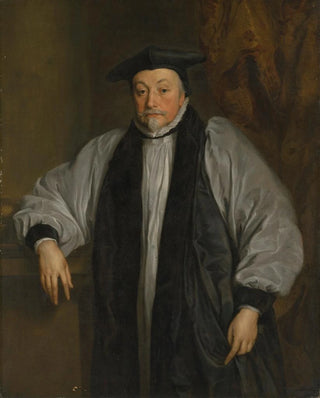Art print | Portrait of Archbishop William Laud - School of Antoine van Dyck


View from behind

Frame (optional)
In the world of art, some works transcend their era to become silent witnesses to history. The "Art print of Archbishop William Laud" from the Antoine van Dyck School is one of these iconic pieces. This painting, which captures the essence of an influential man of the 17th century, immerses us in a time marked by religious and political tensions. William Laud, Archbishop of Canterbury, stood at the heart of debates that shaped England, and his portrait, both majestic and introspective, reveals layers of complexity worth exploring. Through this piece, the viewer is invited to contemplate not only the face of a man but also the sociopolitical issues of his time.
Style and uniqueness of the work
The style of this piece is undeniably influenced by the Baroque, characterized by a dramatic use of light and shadow, as well as meticulous details that bring the subject to life. Van Dyck, master of the portrait, manages to capture not only Laud's physical appearance but also his character and authority. The choice of colors, ranging from rich purples to shades of gold, evokes the high status of the archbishop while adding an almost spiritual dimension to his representation. Laud's penetrating gaze, which seems to follow the viewer, creates an intimate connection, a silent dialogue between the artwork and its observer. Each brushstroke tells a story, and every fold of fabric reflects an era when art was a privileged means of communication.
The artist and his influence
Antoine van Dyck, a pupil of Rubens, established himself as one of the most renowned portraitists of his time. His influence on the genre of portraiture is undeniable, as he combined the grandeur of his subjects with a more personal and psychological approach. By painting eminent figures of his era, he contributed to redefining how aristocrats and clergy members were depicted. Van Dyck also introduced a certain elegance and sophistication into the

Matte finish

View from behind

Frame (optional)
In the world of art, some works transcend their era to become silent witnesses to history. The "Art print of Archbishop William Laud" from the Antoine van Dyck School is one of these iconic pieces. This painting, which captures the essence of an influential man of the 17th century, immerses us in a time marked by religious and political tensions. William Laud, Archbishop of Canterbury, stood at the heart of debates that shaped England, and his portrait, both majestic and introspective, reveals layers of complexity worth exploring. Through this piece, the viewer is invited to contemplate not only the face of a man but also the sociopolitical issues of his time.
Style and uniqueness of the work
The style of this piece is undeniably influenced by the Baroque, characterized by a dramatic use of light and shadow, as well as meticulous details that bring the subject to life. Van Dyck, master of the portrait, manages to capture not only Laud's physical appearance but also his character and authority. The choice of colors, ranging from rich purples to shades of gold, evokes the high status of the archbishop while adding an almost spiritual dimension to his representation. Laud's penetrating gaze, which seems to follow the viewer, creates an intimate connection, a silent dialogue between the artwork and its observer. Each brushstroke tells a story, and every fold of fabric reflects an era when art was a privileged means of communication.
The artist and his influence
Antoine van Dyck, a pupil of Rubens, established himself as one of the most renowned portraitists of his time. His influence on the genre of portraiture is undeniable, as he combined the grandeur of his subjects with a more personal and psychological approach. By painting eminent figures of his era, he contributed to redefining how aristocrats and clergy members were depicted. Van Dyck also introduced a certain elegance and sophistication into the






